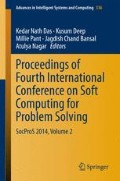Abstract
In the present research work, ZnO nanoparticles were synthesized using a simple precipitation sol-gel method with zinc sulfate as precursor and sodium hydroxide as reagent. Taguchi method was utilized for optimization of process parameters with respect to average particle size and particle size distribution of ZnO nanoparticles as output parameters. FESEM studies were performed for understanding the average particle size of ZnO nanoparticles, while the purity was confirmed by energy dispersive spectroscopy analysis. In the present study, we report formation of mono-sized spherical ZnO nanoparticles with lowest average particle size of 78 nm which was obtained at experimental conditions of molar ratio of 1:2, reaction time of 10 h, and calcination temperature of 700 °C. Also, optimal conditions were determined, and it was found that molar ratio of zinc sulfate and sodium hydroxide is the most significant parameter for affecting particle size of ZnO nanoparticles.
Access this chapter
Tax calculation will be finalised at checkout
Purchases are for personal use only
References
Nohavica, D., Gladkov, P.: ZnO nanoparticles and their applications-new achievements. Olomouc, Czech Republic, EU.10, pp. 12–14 (2010)
Radzimska, A.K., Jesionowski, T.: Zinc oxide-from synthesis to application: a review, mater (2014). doi:10.3390/ma7042833
Vaseem, M., Umar, A., Hahn, Y. B.: ZnO nanoparticles: growth, properties, and applications. In: Umar, A., Hahn, Y.B. (eds.) Metal Oxide Nanostructures and Their Application, vol. 5, pp. 1–36. American Scientific Publishers, New York (2010)
Ghomi, J.S., Ghasemzadeh, M.A., Zahedi, S.: ZnO Nanoparticles: A Highly Effective and Readily Recyclable Catalyst for the One-Pot Synthesis of 1, 8-dioxo-decahydroacridine and 1, 8-dioxooctahydro-xanthene Derivatives. J. Mex. Chem. Soc. 57(1), 1–7 (2013)
Aneesh, P.M., Vanaja, K.A., Jayaraj, M.K.: Synthesis of ZnO nanoparticles by hydrothermal method. Nanophotonic Mater IV (2007). doi:10.1117/12.730364
Stypuła, B., Kmita, A., Hajos, M.: Morphology and structure of ZnO nanoparticles produced by electrochemical method. Mater. Sci. 20(1), 3–9 (2014)
Chu, D., Li, S.: Growth and electrical properties of doped ZnO by electrochemical deposition. New J. Glass Ceram. 2, 13–16 (2012)
Darezereshki, E., Alizadeh, M., Bakhtiari, F., Schaffie, M., Ranjbar, M.: A novel thermal decomposition method for the synthesis of ZnO nanoparticles from low concentration ZnSO4 solutions. Appl. Clay Sci. 54, 107–111 (2011)
Hutera, B., Kmita, A., Olejnik, E., Tokarski, T.: Synthesis of Zno nanoparticles by thermal decomposition of basic zinc carbonate. Arch. Metall. Mater. 58(2), 489–491 (2013)
Wang, R.C., Tsai, C.C.: Efficient synthesis of ZnO nanoparticles, nanowalls, and nanowires by thermal decomposition of zinc acetate at a low temperature. Appl. Phys. A 94, 241–245 (2009)
Djenadic, R., Winterer, M.: Chemical vapor synthesis of nanocrystalline oxides. In: Lorke, A., et al. (eds.) Nanoparticles from the Gas Phase, Nanoscience and Technology, pp. 49–76. Springer, Berlin Heidelberg (2012)
Singh, S.C., Gopal, R.: Zinc nanoparticles in solution by laser ablation technique. Bull. Mater. Sci. 30(3), 291–293 (2007)
Kolekar, T.V., Yadav, H.M., Bandgar, S.S., Deshmukh, P.Y.: Synthesis by sol–gel method and characterization of Zno nanoparticles. Indian Streams Res. J. 1(1), 1–4 (2011)
Chen, C., Yu, B., Liu, P., Liu, J.F., Wang, L.: Investigation of nano-sized ZnO particles fabricated by various synthesis routes. J. Ceram. Process. Res. 12(4), 420–425 (2011)
Hong, R.Y., Li, J.H., Chen, L.L., Liu, D.Q., Li, H.Z., Zheng, Y., Ding, J.: Synthesis, surface modification and photocatalytic property of ZnO nanoparticles. Powder Technol. 189, 426–432 (2009)
Chena, C., Yua, B., Liub, P., Liua, J.F., Wanga, L.: Investigation of nano-sized ZnO particles fabricated by various synthesis routes. J. Ceram. Process. Res. 12(4), 420–425 (2011)
Ristiac, M., Musiac, S., Ivanda, M., Popoviac, S.: Sol–gel synthesis and characterization of nanocrystalline ZnO powders. J. Alloys Compd. 397, 1–L (2005)
Kim, K.D., Choi, D.W., Choa, Y.H., Kim, H.T.: optimization of parameters for synthesis of zinc oxide nanoparticles by Taguchi robust design method. Physicochem. Colloid Surf. A 311, 170–173 (2007)
Kim, K.D., Choi, D.W., Choa, Y.H., Kim, H.T.: Optimization of experimental conditions based on the Taguchi robust design for the formation of nano-sized silver particles by chemical reduction method 104(15), 55–61 (2004)
Somashekara, H.M.: Optimizing surface roughness in turning operation using Taguchi technique and anova. Int. J. Appl. Res. Stud. 4(5), 1–7 (2012)
Gulhane, U.D., Dixit, A.B., Bane, P.V., Salvi, G.S.: Optimization of process parameters For 316 l stainless steel using taguchi method and anova. Int. J. Latest Trends Eng. Technol. 3(2), 67–72 (2012)
Acknowledgments
The authors would like to express their gratitude to Prof. N.V. Deshpande, Director NIT Silchar for his continuous encouragement and support. The work forms a part of M.Tech thesis work of Mr. Tankeshwar Prasad.
Author information
Authors and Affiliations
Corresponding author
Editor information
Editors and Affiliations
Rights and permissions
Copyright information
© 2015 Springer India
About this paper
Cite this paper
Prasad, T., Halder, S. (2015). Optimization of Parameters and its Effect on Size of ZnO Nanoparticles Synthesized by Sol-gel Method. In: Das, K., Deep, K., Pant, M., Bansal, J., Nagar, A. (eds) Proceedings of Fourth International Conference on Soft Computing for Problem Solving. Advances in Intelligent Systems and Computing, vol 336. Springer, New Delhi. https://doi.org/10.1007/978-81-322-2220-0_32
Download citation
DOI: https://doi.org/10.1007/978-81-322-2220-0_32
Published:
Publisher Name: Springer, New Delhi
Print ISBN: 978-81-322-2219-4
Online ISBN: 978-81-322-2220-0
eBook Packages: EngineeringEngineering (R0)

